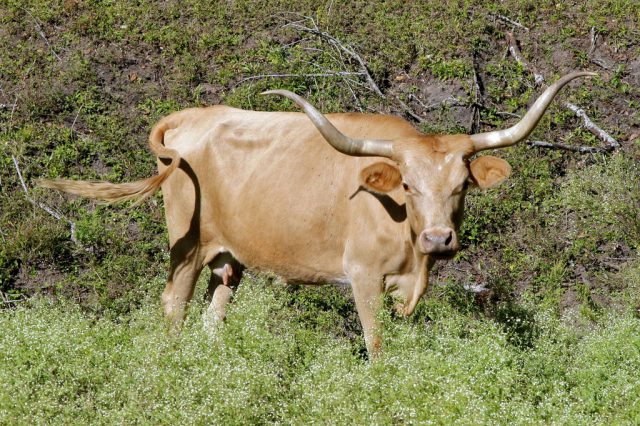Type the name of the breed you're looking for below
[wpdreams_ajaxsearchlite] Don't see the breed your're looking for? Click here and let us know!
Texas Longhorn cattle
| Place of Origin | United States |
| Origin | Genetic analyses show the Longhorn originated from an Iberian hybrid of two ancient cattle lineages: "taurine" descending from the domestication of the wild aurochs in the Middle East, and "indicine", descending from the domestication of the aurochs in India, 85% and 15% respectively by proportion. The Texas Longhorns are direct descendants of the first cattle in the New World. The ancestral cattle were first brought over by Christopher Columbus in 1493 to the Caribbean island of Hispaniola. Between 1493 and 1512, Spanish colonists brought additional cattle in subsequent expeditions. The cattle consisted of three different breeds; Barrenda, Retinto and Grande Pieto. Over the next two centuries the Spanish moved the cattle north, arriving in the area that would become Texas near the end of the 17th century. The cattle escaped or were turned loose on the open range, where they remained mostly feral for the next two centuries. Over several generations, descendants of these cattle evolved the high feed- and drought-stress tolerance and other "hardy" characteristics that Longhorns have become known for. Early US settlers in Texas obtained feral Mexican cattle from the borderland between the Nueces River and the Rio Grande and mixed them with their own eastern cattle. The result was a tough, rangy animal with long legs and long horns extending up to seven feet. Although this interbreeding was of little consequence to the makeup of a Longhorn, it did alter colour. The varieties of colour ranged from bluish-grey, and various yellowish hues, to browns, black, ruddy and white, both cleanly bright and dirty-speckled. Portuguese cattle breeds, such as Alentejana and Mertolenga, are the closest relatives of Texas Longhorns. As Texas became more heavily settled following annexation by the US, the frontier gave way to established farms and ranch lands. The leaner longhorn beef was not as attractive in an era where tallow was highly prized, and the longhorn's ability to survive on the poor vegetation of the open range was no longer as much of an issue. Other breeds demonstrated traits more highly valued by the modern rancher, such as the ability to gain weight quickly. The Texas Longhorn stock slowly dwindled, until in 1927 the breed was saved from near extinction by enthusiasts from the United States Forest Service, who collected a small herd of stock to breed on the Wichita Mountains Wildlife Refuge in Lawton, Oklahoma. A few years later, J. Frank Dobie and others gathered small herds to keep in Texas state parks. They were cared for largely as curiosities, but the stock's longevity, resistance to disease and ability to thrive on marginal pastures quickly revived the breed as beef stock. Today, the breed is used as a beef stock, though many Texas ranchers keep herds due to their link to Texas history. |
| Purpose | Most breeds of cattle fall into either beef or dairy. The Texas Longhorn is principally a beef animal and is known for its lean beef, which is lower in fat, cholesterol and calories than most beef. |
| Appearance | A longhorn can be any colour or mix of colours, but dark red and white colour mixes are the most dominant. |
| Horns | Known for its characteristic horns, which can extend to 7 ft (2.1 m) tip to tip for steers and exceptional cows, and 36 to 80 in (0.91 to 2.03 m) tip to tip for bulls. |
| Other Considerations | In Culture; A Longhorn, the logo for the University of Texas sports teamsThe Texas Longhorn is the current mascot of the University of Texas at Austin. Defender Torozord, a mecha featured in Power Rangers: Lost Galaxy, is modeled after a Texas Longhorn. |



